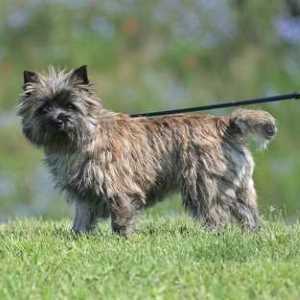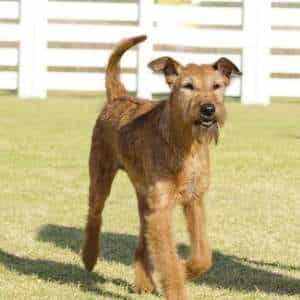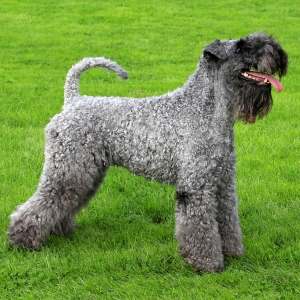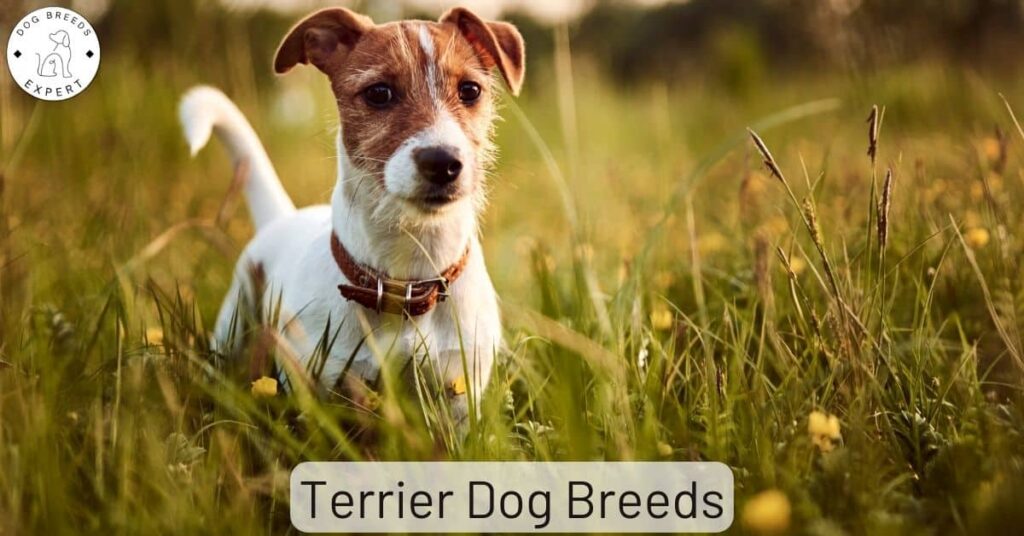Terrier dog breeds can be described as busy, feisty, and active.
Terriers prefer to be part of the action and have a real zest for life. They make awesome family pets for people who do not keep small pocket pets such as hamsters or gerbils. Terriers look at these smaller mammals as vermin that must be eliminated.
Most terriers are easily identified as belonging to this group because “terrier” is part of their name: Cairn Terriers, Irish Terriers, Scottish Terriers, West Highland White Terriers.

However, Yorkshire Terriers, Tibetan Terriers, and Biewer Terriers are not considered terriers at all according to the American Kennel Club, so don’t rely on the name to help you classify these dogs. They are considered Terriers in other organizations such as the Fédération Cynologique Internationale (FCI).
Modern day Terriers can trace their roots back to the British Isles and were originally kept by peasants to control the pest population.
Many were proven to be tireless “ratters”, loyal and determined to serve their humans. Over time, they became companions as well as working dogs.
Why so Many Different Terrier Dog Breeds?
Why do you need so many different types of terriers to kill a rat or two?
There were a wide variety of terrains in Britain and early terrier breeders had to develop dogs that could adapt to the local conditions. Some terriers were long-legged and others had short legs.
Some had smooth coats and others rough ones. Some have silky or wavy coats or even mixed coats. Eventually some of the members of this group became known as fighting dogs, a sport that has been banned in Britain and the U.S.
Some of the dogs not recognized by the AKC have terrier blood in their pedigrees.
Terrier Dog Breeds: More Alike than Different
- High Energy
- Intelligence
- Strong Prey Drive
- Independent Streak
- Bark
- Dig
- Dog Aggression
What do Terriers Have in Common?
As a group, even though there are differences, terriers are more similar than different. Beyond size, leg length or coat type, they are all agile, fast and athletic.
They are intelligent, impulsive and very clever. They are capable of coming up with solutions to problems, whether we agree with their answers or not.
Terriers are also independent and stubborn (at least many are considered stubborn). Some can be dominant and demanding. Some are challenging to own, especially when you combine high energy, independence, courageousness, persistence and curiosity.
All terriers have a strong prey drive and none can be 100% reliable around small pets such as hamsters, gerbils and guinea pigs.
All have a degree of dog-on-dog aggression.
All dogs bark and most will dig.
AKC Terrier Dog Breeds
Airedale Terrier

The Airedale Terrier is also known as “The King of Terriers”, because they are the largest of the terrier breeds. They are from the Airedale Valley region of northern England, and are feisty, exuberant and brave.
As well as catching rats, they were big and brave enough to go after weasels, otters and wildcats. Due to their size and heritage, they are good watch dogs and guard dogs. Grooming is moderate, as they have a thick wiry coat that does not shed – dead hair needs to be brushed out.
American Hairless Terrier

The American Hairless is a small terrier with a recent history, only being recognized by the AKC in 2016. They are intelligent, smart and eager to learn. With no coat they are easy to groom, but need protection from strong sun as they can burn easily. They also lose heat quickly and need a dog jacket if out in cooler temperatures.
American Staffordshire Terrier

The American Staffordshire Terrier is sometimes mistaken for a Pit Bull Terrier, but this is a mistake, and the issue is much more complicated. The “Am Staff” is actually very good with children, and makes for a good family pet when well trained. Although strong and brave, they are not aggressive nor vicious by nature.
These dogs are smart and playful, and enjoy family activities that they can take part in. Some may not tolerate other dogs well, unless they have been brought up together, and new family pets such as rabbits and cats may be at risk if they have not been introduced at a young age.
Australian Terrier

Origins: Australia
Size: Small
Grooming: Average
Training: Easy
Recognition: FCI: Group 3,AKC: Terriers, ANKC: Terriers,CKC: Terriers, KC: Terriers, NZKC: Terriers, UKC: Terriers
Bedlington Terrier

The Bedlington Terrier has a deceptive appearance – it looks fluffy and soft, but it is hardy and feisty at heart. This breed is a little quieter than most Terrier breeds, ad tends to be calmer around the house.
Like all Terriers, they were bred to catch mice, rats, and also badgers and foxes. They are fairly easy to train, but are active dogs and need a good amount of exercise to keep them healthy. Grooming is high maintenance, as their coat needs a daily brushing, and occasional trimming.
Border Terrier

Often described as persistent, agile and intelligent, they are also very friendly, and will welcome all visitors to the home. They are also quite vocal, and bark readily at anything happening, so maybe not the best dog if you have close neighbors.
Bred as working dogs to control vermin in the border area between Scotland and England, they still have a strong prey instinct, and are likely to go after any small animals including the family rabbit. They are easy to train amd love learning new tricks!
Bull Terrier

The English Bull Terrier is an instantly recognizable breed due to its distinctive egg-shaped head and small triangular eyes. Well muscled and powerful, this breed was created 150 years ago by crossing the English Bulldog with the now-extinct English White Terrier, and was used for bull-baiting.
Despite this heritage, the modern Bull Terrier is a very good family dog, and great with children. They can be independent and stubborn, and need careful training. Grooming is easy, with short glossy coat.
Terrier Dog Breeds
Cairn Terrier

Origins: Scotland
Size: Small
Grooming: Average
Training: Average
Recognition: CKC (Terriers), ANKC (Terriers), AKC (Terriers), NZKC (Terriers), UKC (Terrier, (UK) Terrier, FCI Group 3
Cesky Terrier

Origins: The Czech Republic
Size: Small
Grooming: Average
Training: Average
Recognition: CKC (Terriers), ANKC (Terriers), KC (Terriers), AKC (Terriers), NZKC (Terriers) , UKC (Terriers), FCI (Group 6)
Dandie Dinmont Terrier

Origins: Scotland
Size: Small
Grooming: Average
Training: Average
Recognition: AKC (Terrier), FCI (Group 3), KC (Terrier), UKC (Terrier), ANKC (Terriers), CKC (Terriers), NZKC (Terriers)
Glen of Imaal Terrier

Origins: Ireland
Size: Small to Medium
Grooming: Average
Training: Average
Recognition: FCI: Group 3, AKC: Terrier, ANKC: Terrier, CKC: Miscellaneous, KC: Terrier, NZKC: Terrier, UKC: Terrier
Irish Terrier

Origins: Ireland
Size: Small to Medium
Grooming: Average
Training: Average
Recognition: FCI: Group 3AKC: Ter, rier, ANKC: Terrier, CKC: Terrier, KC: Terrier, NZKC: Terrier, UKC: Terrier
Jack Russell Terrier

Height: 10-12 in (25-30 cm)
Weight: 11-13lb (5-6kg)
Origin: UK
Ease of Training: Challenging
Japanese Terrier

Height: 15-16 in (38-42 cm)
Weight: 17-18 lb (7.6-8 kg)
Origin: Japan
Ease of Training: Medium
Kerry Blue Terrier

Origins: Ireland
Size: Medium
Grooming: Time Consuming
Training: Average
Recognition: FCI: Group 3, AKC: Terriers, ANKC: Terriers, CKC: Terriers, KC: Terriers, NZKC: Terriers, UKC: Terriers
Lakeland Terrier

Origins: United Kingdom
Size: Small
Grooming: Average
Training: Time Consuming
Recognition: FCI: Group 3, AKC: Terrier, ANKC: Terrier, CKC: Terrier, KC: Terrier, NZKC: Terrier, UKC: Terrier
Manchester Terrier

Bred to hunt and kill rats, the Manchester Terrier is alert and wary of strangers. This makes him a good watch dog, who will quickly alert his owner to any unusual activity. They are lively and active, and tend to chase and dig.
They are exceptionally smart and learn quickly. Grooming is very easy, as they have a short smooth coat that doesn’t get matted or tangled. This is a healthy breed, and doesn’t tend to suffer from many problems.
Miniature Bull Terrier

Origins: England
Size: Medium
Grooming: Easy
Training: Average
Recognition: Recognition: AKC: Terrier, ANKC: Terriers, CKC: Terriers, NZKC: Terrier (Miniature), UKC: Terrier
Miniature Schnauzer

Have you ever wondered how the Miniature Schnauzer got to be so much smaller than his standard and giant cousins? This is a prime example of how breeders can breed-down or miniaturize a larger breed.
This breed is most common of the Schnauzers, for many reasons. Owners enjoy their affectionate and loyal personalities, which is paired with their playful energy. Their intelligence makes them responsive and quick learners.
Norfolk Terrier

Origins: Great Britain
Size: Small
Grooming: Average
Training: Easy
Recognition: FCI: Group 3, AKC: Terriers, ANKC: Terriers, CKC: Terriers, KC: Terriers, NZKC: Terriers, UKC: Terriers
Norwich Terrier

Origins: Great Britain
Size: Small
Grooming: Average
Training: Average
Recognition: FCI: Group 3, AKC: Terriers, ANKC: Terriers, CKC: Terriers, KC: Terriers, NZKC: Terriers, UKC: Terriers
Parson Russell Terrier

Origins: England
Size: Small
Grooming: Easy
Training: Average
Recognition: FCI: Group 3, AKC: Terrier, ANKC: Terrier, CKC: Terrier, KC: Terrier, NZKC: Terrier, UKC: Terrier
Rat Terrier

Origins: The United States
Size: Small
Grooming: Easy
Training: Average
Recognition: AKC: Terrier, UKC: Terrier
An American dog breed used for controlling rats on farms, which has now become a sturdy and affectionate companion dog. They are intelligent and quick to learn, but have a stubborn streak which needs careful managing as a puppy.
With a long breeding history and a big gene pool, the Rat Terrier is a healthy and robust dog with few health issues. They are easy to groom, with a short smooth coat, and make good family dogs.
Scottish Terrier

Origins: Scotland
Size: Small
Grooming: Time Consuming
Training: Time Consuming
Recognition:, FCI: Group 3, AKC: Terriers, ANKC: Terriers, CKC: Terriers, KC: Terriers, NZKC:Terriers, UKC: Terriers
Sealyham Terrier

Origins: Wales
Size: Small
Grooming: Moderate
Training: Challenging
Recognition:, FCI: Group 3, AKC: Terriers, ANKC: Terriers, CKC: Terriers, KC:Terriers, NZKC: Terriers, UKC: Terriers
Silky Terrier

Origins: Australia
Size: Small / Toy
Grooming: Time Consuming
Training: Easy
Recognition: FCI: Group 3, AKC: Toys, ANKC: Toys, CKC: Toys, KC: Toys, NZKC: Toys, UKC: Terrier
Skye Terrier

Origins: Scotland
Size: Small
Grooming: Time Consuming
Training: Time Consuming
Recognition: FCI: Group 3, AKC: Terrier, ANKC: Terrier, CKC: Terrier, KC:Terrier, NZKC: Terrier, UKC: Terrier
Smooth Fox Terrier

Soft Coated Wheaten Terrier

Origins: Ireland
Size: Medium
Grooming: Time Consuming
Training: Average
Recognition: FCI: Group 3, AKC: Terriers, ANKC: Terriers, CKC: Terriers, KC: Terriers, NZKC: Terriers, UKC: Terriers
Staffordshire Bull Terrier

Origins: England
Size: Medium
Grooming: Easy
Training: Time Consuming
Recognition: FCI: Group 3, AKC: Terrier, ANKC: Terrier, CKC: Terrier, KC: Terrier, NZKC: Terrier, UKC: Terrier
Welsh Terrier

This is one independent dog that loves to do their own thing and is not dead set on pleasing their owners. It may be a difficult breed for a first-time dog owner to take on, especially because they are a little higher maintenance than your average dog, but for dog owner veterans, it can be a fun challenge to take on this breed as a new member of your family.
Something unusual and unique to the Welsh is that they live for challenges and will never back down from a challenge if one is at hand. It’s as if they don’t know how to not take on a challenge if one is presented to them.
West Highland White Terrier

The West Highland White Terrier is best described as alert, active, independent and friendly. While not considered to be hyper, they are energetic and will need plenty of exercises which suggest that they might not be suitable for couch potatoes.
The breed as a whole usually gets along well with other dogs and household pets, but as you might expect, two unaltered males may not become best friends, especially if an altered female is nearby. The West Highland White Terrier will view any small household pets as potential prey, so hamsters, guinea pigs or gerbils do not stand much of a chance in a home with a Westie.
Wire Fox Terrier

Origins: Great Britain
Size: Small
Grooming: Average
Training: Time Consuming
Recognition: FCI: Group 3, AKC: Terrier, ANKC: Terrier, CKC: Terrier, KC: Terrier, NZKC: Terrier, UKC: Terrier
Yorkshire Terrier

Bold, affectionate, bright and fearless are words often used to describe the Yorkie’s personality. They enjoy adventures as well as snuggles, but they still maintain the terrier part of their temperament, which means they can be feisty and vocal.
Today,this breed is very popular and in 2014, the Yorkshire Terrier was ranked number 6 in popularity in the United States by the American Kennel Club. As a bright breed, Yorkies are generally easy to train. Positive praise, attention, and food rewards work well.
More Terrier Dog Breeds (Non- AKC)
These dogs may be AKC breeds but classified in a different group, such as the Yorkshire Terrier. Yorkies are part of AKC Toy Group.
Others are not recognized by AKC, but may be recognized by another large Kennel Club. A good example of this is the American Pit Bull Terrier. Pit Bulls are recognized by the United Kennel Club.
Where appropriate, I have tried to list the kennel club that recognizes the breed.
American Pit Bull Terrier: UKC
Austrian Pinscher: Recognized by the UKC
Brazilian Terrier: FCI
Danish Swedish Farm Dog: Recognized by the UKC
Dutch Smoushond: UKC
German Pinscher: UKC
German Hunting Terrier (Jagdterrier): UKC, ANKC
Jack Russell Terrier: UKC, ANKC, FCI
Japanese Terrier: UKC, FCI
Mountain Feist: UKC
Patterdale Terrier: UKC
Sporting Lucas Terrier: UKC
Teddy Roosevelt Terrier: UKC
Tenterfield Terrier: ANKC
Treeing Feist: UKC



